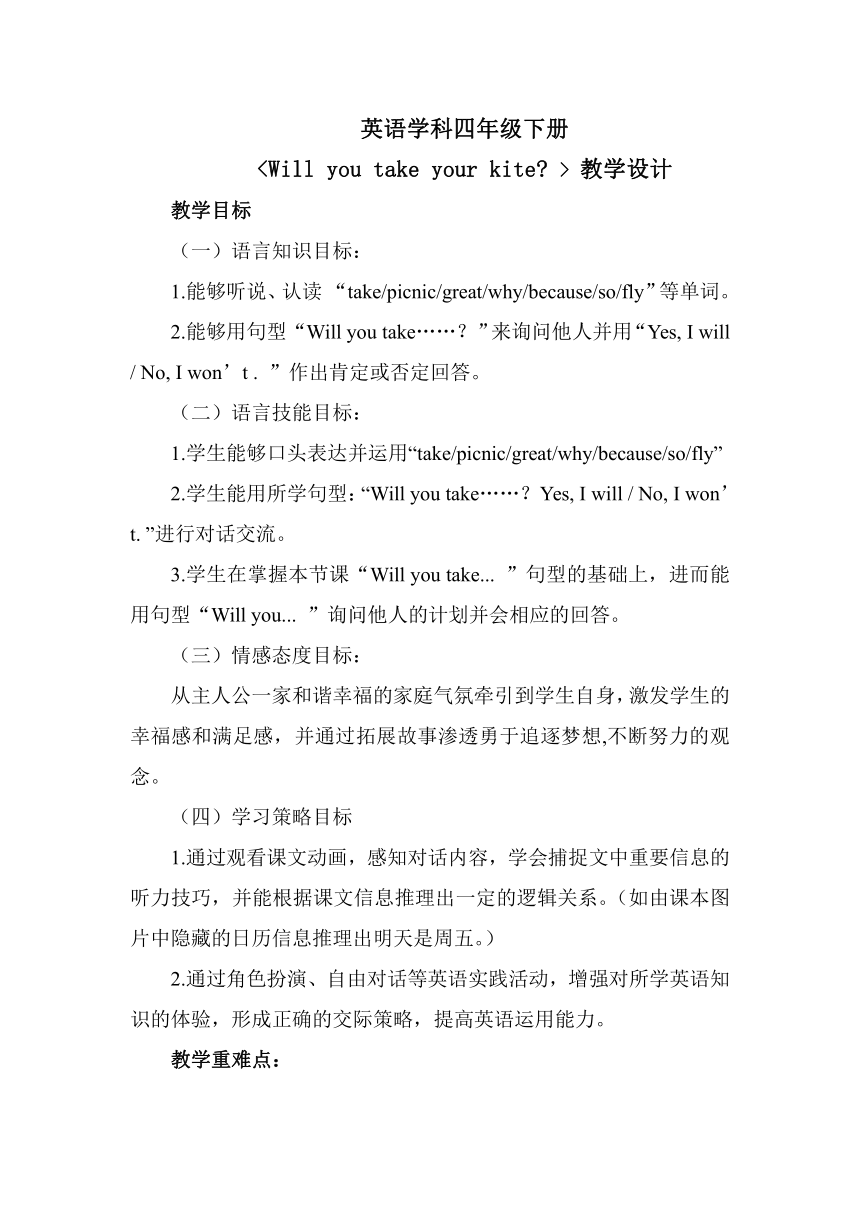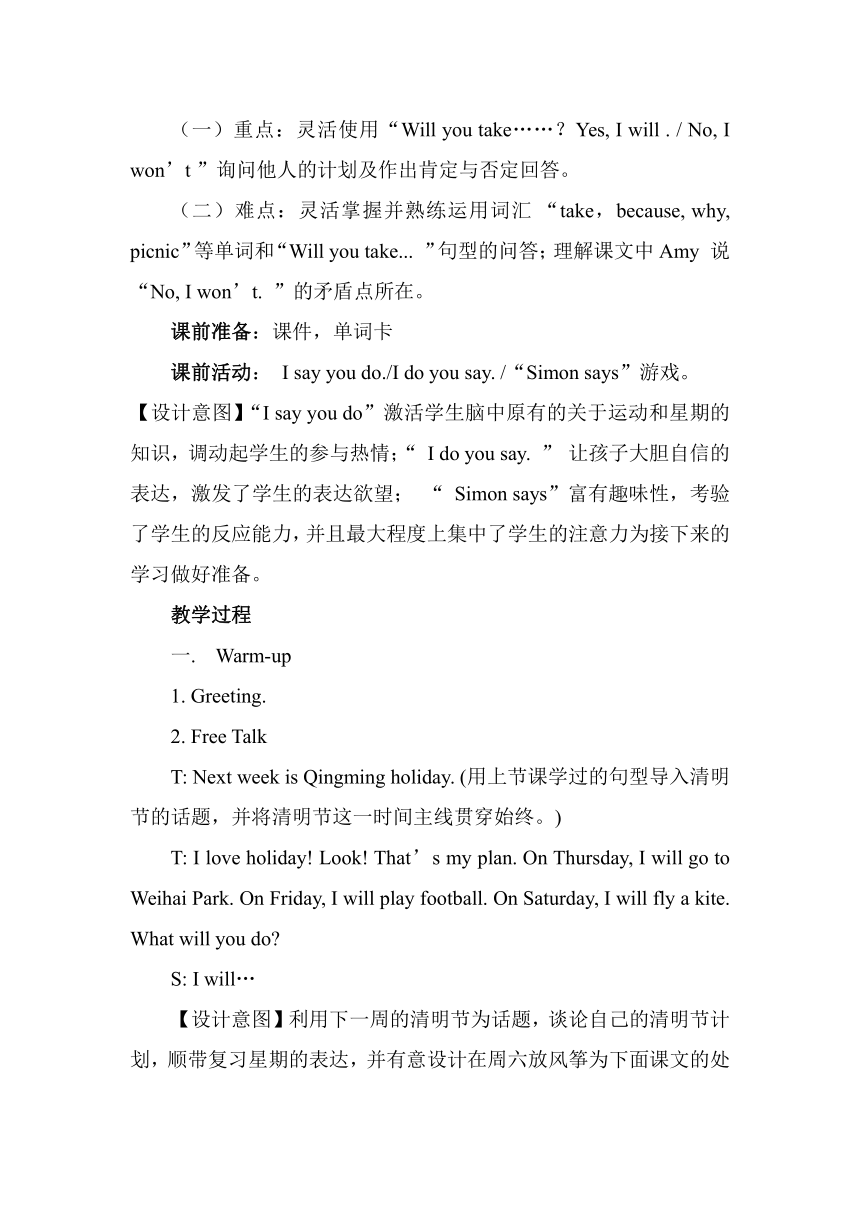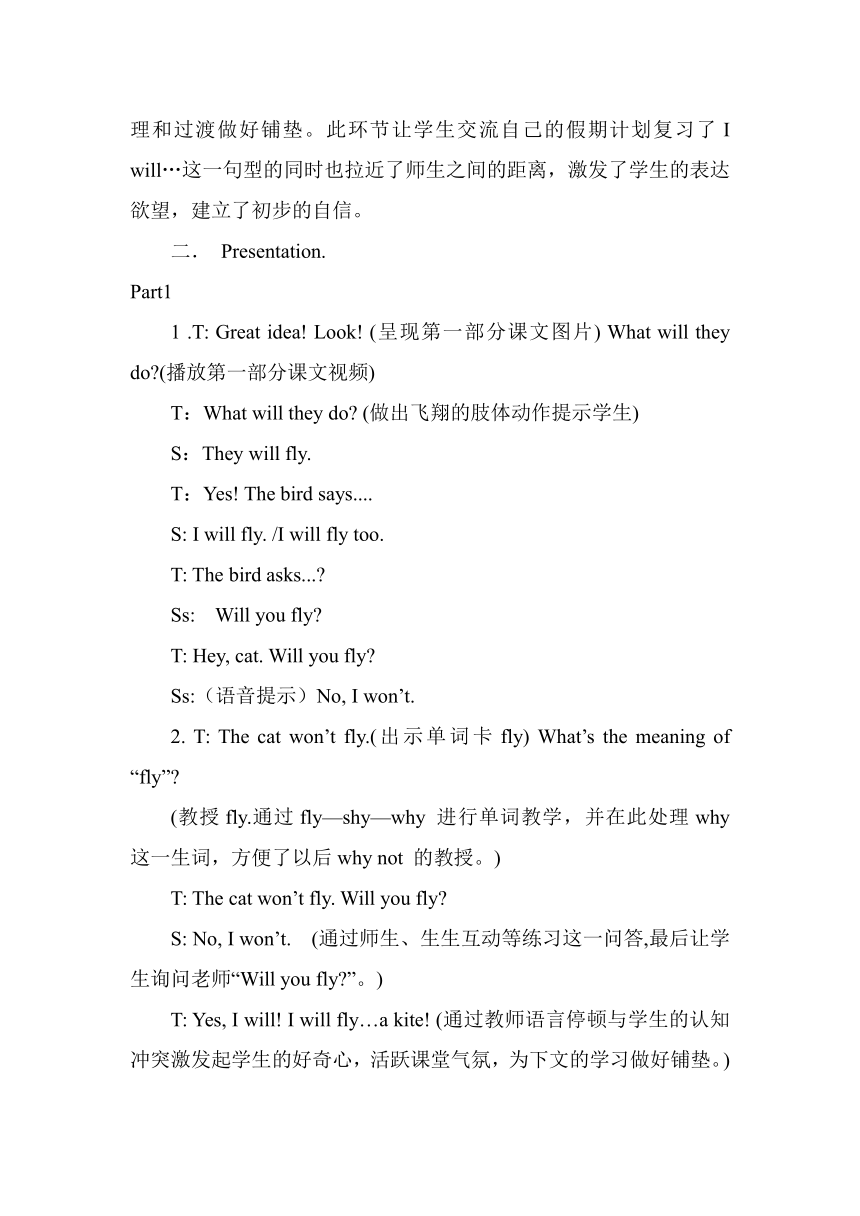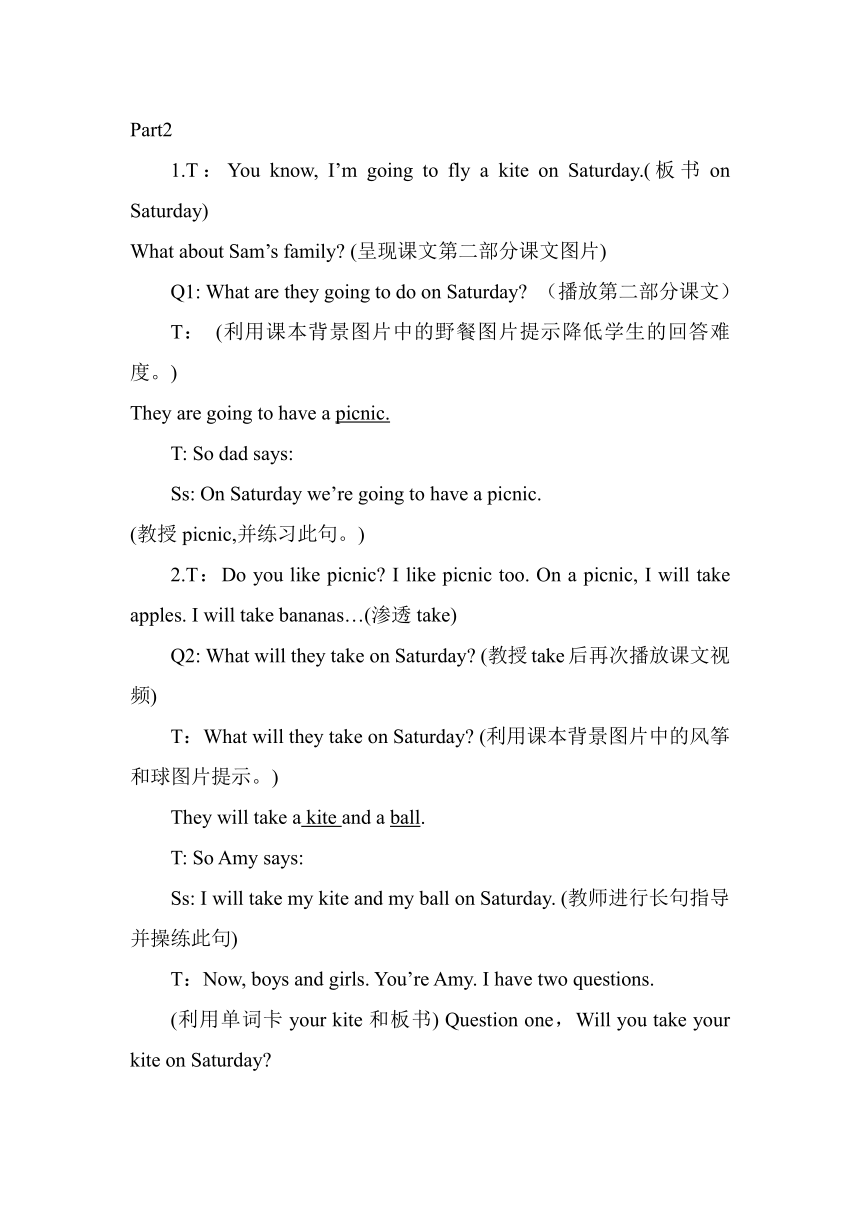外研版(三年级起点)四年级英语下册 Review Module Unit 1 教案
文档属性
| 名称 | 外研版(三年级起点)四年级英语下册 Review Module Unit 1 教案 |  | |
| 格式 | doc | ||
| 文件大小 | 53.5KB | ||
| 资源类型 | 教案 | ||
| 版本资源 | 外研版(三年级起点) | ||
| 科目 | 英语 | ||
| 更新时间 | 2022-07-04 19:42:35 | ||
图片预览




文档简介
英语学科四年级下册
教学设计
教学目标
(一)语言知识目标:
1.能够听说、认读 “take/picnic/great/why/because/so/fly”等单词。
2.能够用句型 “Will you take……?”来询问他人并用“Yes, I will / No, I won’t . ”作出肯定或否定回答。
(二)语言技能目标:
1.学生能够口头表达并运用“take/picnic/great/why/because/so/fly”
2.学生能用所学句型:“Will you take……?Yes, I will / No, I won’t. ”进行对话交流。
3.学生在掌握本节课“Will you take... ”句型的基础上,进而能用句型“Will you... ”询问他人的计划并会相应的回答。
(三)情感态度目标:
从主人公一家和谐幸福的家庭气氛牵引到学生自身,激发学生的幸福感和满足感,并通过拓展故事渗透勇于追逐梦想,不断努力的观念。
(四)学习策略目标
1.通过观看课文动画,感知对话内容,学会捕捉文中重要信息的听力技巧,并能根据课文信息推理出一定的逻辑关系。(如由课本图片中隐藏的日历信息推理出明天是周五。)
2.通过角色扮演、自由对话等英语实践活动,增强对所学英语知识的体验,形成正确的交际策略,提高英语运用能力。
教学重难点:
(一)重点:灵活使用“Will you take……?Yes, I will . / No, I won’t ”询问他人的计划及作出肯定与否定回答。
(二)难点:灵活掌握并熟练运用词汇 “take,because, why, picnic”等单词和“Will you take... ”句型的问答;理解课文中Amy 说“No, I won’t. ”的矛盾点所在。
课前准备:课件,单词卡
课前活动: I say you do./I do you say. /“Simon says”游戏。
【设计意图】“I say you do”激活学生脑中原有的关于运动和星期的知识,调动起学生的参与热情;“ I do you say. ” 让孩子大胆自信的表达,激发了学生的表达欲望; “ Simon says”富有趣味性,考验了学生的反应能力,并且最大程度上集中了学生的注意力为接下来的学习做好准备。
教学过程
一. Warm-up
1. Greeting.
2. Free Talk
T: Next week is Qingming holiday. (用上节课学过的句型导入清明节的话题,并将清明节这一时间主线贯穿始终。)
T: I love holiday! Look! That’s my plan. On Thursday, I will go to Weihai Park. On Friday, I will play football. On Saturday, I will fly a kite. What will you do
S: I will…
【设计意图】利用下一周的清明节为话题,谈论自己的清明节计划,顺带复习星期的表达,并有意设计在周六放风筝为下面课文的处理和过渡做好铺垫。此环节让学生交流自己的假期计划复习了I will…这一句型的同时也拉近了师生之间的距离,激发了学生的表达欲望,建立了初步的自信。
二. Presentation.
Part1
1 .T: Great idea! Look! (呈现第一部分课文图片) What will they do (播放第一部分课文视频)
T:What will they do (做出飞翔的肢体动作提示学生)
S:They will fly.
T:Yes! The bird says....
S: I will fly. /I will fly too.
T: The bird asks...
Ss: Will you fly
T: Hey, cat. Will you fly
Ss:(语音提示)No, I won’t.
2. T: The cat won’t fly.(出示单词卡fly) What’s the meaning of “fly”
(教授fly.通过fly—shy—why 进行单词教学,并在此处理why这一生词,方便了以后why not 的教授。)
T: The cat won’t fly. Will you fly
S: No, I won’t. (通过师生、生生互动等练习这一问答,最后让学生询问老师“Will you fly ”。)
T: Yes, I will! I will fly…a kite! (通过教师语言停顿与学生的认知冲突激发起学生的好奇心,活跃课堂气氛,为下文的学习做好铺垫。)
Part2
1.T:You know, I’m going to fly a kite on Saturday.(板书on Saturday)
What about Sam’s family (呈现课文第二部分课文图片)
Q1: What are they going to do on Saturday (播放第二部分课文)
T: (利用课本背景图片中的野餐图片提示降低学生的回答难度。)
They are going to have a picnic.
T: So dad says:
Ss: On Saturday we’re going to have a picnic.
(教授picnic,并练习此句。)
2.T:Do you like picnic I like picnic too. On a picnic, I will take apples. I will take bananas…(渗透take)
Q2: What will they take on Saturday (教授take后再次播放课文视频)
T:What will they take on Saturday (利用课本背景图片中的风筝和球图片提示。)
They will take a kite and a ball.
T: So Amy says:
Ss: I will take my kite and my ball on Saturday. (教师进行长句指导并操练此句)
T:Now, boys and girls. You’re Amy. I have two questions.
(利用单词卡your kite和板书) Question one,Will you take your kite on Saturday
Ss: Yes, I will. (提示学生补充完整此句肯定回答并板书。)
T: Question two,Will you take your ball on Saturday
Ss: Yes I will.
3. T: But Amy says: (语音“No, I won’t. ”)
Q3: What does Sam say (自读课文找答案。)
S1/S2:Will you take your kite tomorrow (板书tomorrow并强调这一时间点。)
S1/S2 : Will you take your ball tomorrow
(通过师生、生生练习这一句型的问答。)
4. T: (指出课件上Thursday的日历和黑板上Saturday,tomorrow三个时间条,引导学生思考。) No, I won’t. No, I won’t. Why not
Ss: Because tomorrow is Friday!
T;Bingo!We’re going to have a picnic on Saturday!
And what’s the meaning of because (教授because,练习其发音)
T:Boys and girls, will you go to school tomorrow
Ss: Yes, I will.
Will you go to school on Qingming holiday
Ss: No, I won’t.
T:Will you do the homework /help your mum/play with your friends on Qingming holiday
(与学生互动进一步巩固学生对于新知的理解,复习了之前学过的词组do the homework /help your mum/play with your friend,在对学生的评价和互动中无形中渗透了帮助妈妈,与人友善,努力学习等理念。)
5. T: Now let’s listen, point and say. (跟读课文)
T:What a happy family! (此处渗透德育:Amy的家庭很幸福很和睦,我们也很幸福,因为我们生活在一个大家庭里,班级、学校、国家都是我们幸福的家。)
T: Now it’s your turn. Read it in pairs.
(分别进行同桌两人分角色自读,全体分角色读,个体展示读)
三.Practice.
T: They are going to have a picnic on Saturday.
Daming and his robot are going to have a picnic on Qingming holiday.
T:Who wants to be Daming (找一生当大明与老师对话。)
S: We’re going to have a picnic on Saturday.
T: Will you take a ball (教师用机器人的语气表达激发学生兴趣。)
S:...
T: Will you take a toy car
T: ...
T:What will you do on Qingming holiday Talk about it with your desk mate.
T:Great plan! But remember, make a plan before your trip. (德育渗透:旅行前做好计划)
【设计意图】再次启用清明节假期这一时间主线,利用前一单元的主人公大明和机器人,设计他们也去野餐这一场景帮助学生练习本课的重点句型, 由大明的计划激发起学生自己清明节计划的讨论,容易引起学生的兴趣,学生操练之前,教师先和一生对话给出示例,为学生的操练指明了方向。
四.Production.
T: Daming is going to have a picnic. The frog is going to London.
Let’s enjoy the story “I’m going to London.”
(播放旅行青蛙的视频)
T: Now, please take out this paper. Read it and finish the story.
同桌两人完成故事的编写并交流。
T: Boys and girls, what did you learn from the story
T: That’s my idea: No dream is too big, no dreamer is too small.
(引导学生一起说出汉语意思烘托气氛)
T:Let’s follow our dream! OK But before that we should study hard and learn English well.
【设计意图】利用当下流行的游戏“旅行青蛙”为主题设计绘本故事,故事讲述青蛙要去伦敦旅行,途中遇到蝴蝶、蚂蚁、螃蟹、猫头鹰等动物,这些动物分别询问青蛙需不要带什么物品,以此练习本节课所学句型的问答,并且通过跟朋友讲述自己要去参观塔桥、大本钟等地点来复习之前学过的英国建筑物的表达。故事结束后渗透小小的青蛙梦想去伦敦最终如愿以偿,有梦想就要去追逐,但是不要忘记努力的观念。
五.Summary
利用板书师生共同总结。
六.Homework.
1. Read the text in your groups.
2. Tell the story to your friends.
板书设计
教学目标
(一)语言知识目标:
1.能够听说、认读 “take/picnic/great/why/because/so/fly”等单词。
2.能够用句型 “Will you take……?”来询问他人并用“Yes, I will / No, I won’t . ”作出肯定或否定回答。
(二)语言技能目标:
1.学生能够口头表达并运用“take/picnic/great/why/because/so/fly”
2.学生能用所学句型:“Will you take……?Yes, I will / No, I won’t. ”进行对话交流。
3.学生在掌握本节课“Will you take... ”句型的基础上,进而能用句型“Will you... ”询问他人的计划并会相应的回答。
(三)情感态度目标:
从主人公一家和谐幸福的家庭气氛牵引到学生自身,激发学生的幸福感和满足感,并通过拓展故事渗透勇于追逐梦想,不断努力的观念。
(四)学习策略目标
1.通过观看课文动画,感知对话内容,学会捕捉文中重要信息的听力技巧,并能根据课文信息推理出一定的逻辑关系。(如由课本图片中隐藏的日历信息推理出明天是周五。)
2.通过角色扮演、自由对话等英语实践活动,增强对所学英语知识的体验,形成正确的交际策略,提高英语运用能力。
教学重难点:
(一)重点:灵活使用“Will you take……?Yes, I will . / No, I won’t ”询问他人的计划及作出肯定与否定回答。
(二)难点:灵活掌握并熟练运用词汇 “take,because, why, picnic”等单词和“Will you take... ”句型的问答;理解课文中Amy 说“No, I won’t. ”的矛盾点所在。
课前准备:课件,单词卡
课前活动: I say you do./I do you say. /“Simon says”游戏。
【设计意图】“I say you do”激活学生脑中原有的关于运动和星期的知识,调动起学生的参与热情;“ I do you say. ” 让孩子大胆自信的表达,激发了学生的表达欲望; “ Simon says”富有趣味性,考验了学生的反应能力,并且最大程度上集中了学生的注意力为接下来的学习做好准备。
教学过程
一. Warm-up
1. Greeting.
2. Free Talk
T: Next week is Qingming holiday. (用上节课学过的句型导入清明节的话题,并将清明节这一时间主线贯穿始终。)
T: I love holiday! Look! That’s my plan. On Thursday, I will go to Weihai Park. On Friday, I will play football. On Saturday, I will fly a kite. What will you do
S: I will…
【设计意图】利用下一周的清明节为话题,谈论自己的清明节计划,顺带复习星期的表达,并有意设计在周六放风筝为下面课文的处理和过渡做好铺垫。此环节让学生交流自己的假期计划复习了I will…这一句型的同时也拉近了师生之间的距离,激发了学生的表达欲望,建立了初步的自信。
二. Presentation.
Part1
1 .T: Great idea! Look! (呈现第一部分课文图片) What will they do (播放第一部分课文视频)
T:What will they do (做出飞翔的肢体动作提示学生)
S:They will fly.
T:Yes! The bird says....
S: I will fly. /I will fly too.
T: The bird asks...
Ss: Will you fly
T: Hey, cat. Will you fly
Ss:(语音提示)No, I won’t.
2. T: The cat won’t fly.(出示单词卡fly) What’s the meaning of “fly”
(教授fly.通过fly—shy—why 进行单词教学,并在此处理why这一生词,方便了以后why not 的教授。)
T: The cat won’t fly. Will you fly
S: No, I won’t. (通过师生、生生互动等练习这一问答,最后让学生询问老师“Will you fly ”。)
T: Yes, I will! I will fly…a kite! (通过教师语言停顿与学生的认知冲突激发起学生的好奇心,活跃课堂气氛,为下文的学习做好铺垫。)
Part2
1.T:You know, I’m going to fly a kite on Saturday.(板书on Saturday)
What about Sam’s family (呈现课文第二部分课文图片)
Q1: What are they going to do on Saturday (播放第二部分课文)
T: (利用课本背景图片中的野餐图片提示降低学生的回答难度。)
They are going to have a picnic.
T: So dad says:
Ss: On Saturday we’re going to have a picnic.
(教授picnic,并练习此句。)
2.T:Do you like picnic I like picnic too. On a picnic, I will take apples. I will take bananas…(渗透take)
Q2: What will they take on Saturday (教授take后再次播放课文视频)
T:What will they take on Saturday (利用课本背景图片中的风筝和球图片提示。)
They will take a kite and a ball.
T: So Amy says:
Ss: I will take my kite and my ball on Saturday. (教师进行长句指导并操练此句)
T:Now, boys and girls. You’re Amy. I have two questions.
(利用单词卡your kite和板书) Question one,Will you take your kite on Saturday
Ss: Yes, I will. (提示学生补充完整此句肯定回答并板书。)
T: Question two,Will you take your ball on Saturday
Ss: Yes I will.
3. T: But Amy says: (语音“No, I won’t. ”)
Q3: What does Sam say (自读课文找答案。)
S1/S2:Will you take your kite tomorrow (板书tomorrow并强调这一时间点。)
S1/S2 : Will you take your ball tomorrow
(通过师生、生生练习这一句型的问答。)
4. T: (指出课件上Thursday的日历和黑板上Saturday,tomorrow三个时间条,引导学生思考。) No, I won’t. No, I won’t. Why not
Ss: Because tomorrow is Friday!
T;Bingo!We’re going to have a picnic on Saturday!
And what’s the meaning of because (教授because,练习其发音)
T:Boys and girls, will you go to school tomorrow
Ss: Yes, I will.
Will you go to school on Qingming holiday
Ss: No, I won’t.
T:Will you do the homework /help your mum/play with your friends on Qingming holiday
(与学生互动进一步巩固学生对于新知的理解,复习了之前学过的词组do the homework /help your mum/play with your friend,在对学生的评价和互动中无形中渗透了帮助妈妈,与人友善,努力学习等理念。)
5. T: Now let’s listen, point and say. (跟读课文)
T:What a happy family! (此处渗透德育:Amy的家庭很幸福很和睦,我们也很幸福,因为我们生活在一个大家庭里,班级、学校、国家都是我们幸福的家。)
T: Now it’s your turn. Read it in pairs.
(分别进行同桌两人分角色自读,全体分角色读,个体展示读)
三.Practice.
T: They are going to have a picnic on Saturday.
Daming and his robot are going to have a picnic on Qingming holiday.
T:Who wants to be Daming (找一生当大明与老师对话。)
S: We’re going to have a picnic on Saturday.
T: Will you take a ball (教师用机器人的语气表达激发学生兴趣。)
S:...
T: Will you take a toy car
T: ...
T:What will you do on Qingming holiday Talk about it with your desk mate.
T:Great plan! But remember, make a plan before your trip. (德育渗透:旅行前做好计划)
【设计意图】再次启用清明节假期这一时间主线,利用前一单元的主人公大明和机器人,设计他们也去野餐这一场景帮助学生练习本课的重点句型, 由大明的计划激发起学生自己清明节计划的讨论,容易引起学生的兴趣,学生操练之前,教师先和一生对话给出示例,为学生的操练指明了方向。
四.Production.
T: Daming is going to have a picnic. The frog is going to London.
Let’s enjoy the story “I’m going to London.”
(播放旅行青蛙的视频)
T: Now, please take out this paper. Read it and finish the story.
同桌两人完成故事的编写并交流。
T: Boys and girls, what did you learn from the story
T: That’s my idea: No dream is too big, no dreamer is too small.
(引导学生一起说出汉语意思烘托气氛)
T:Let’s follow our dream! OK But before that we should study hard and learn English well.
【设计意图】利用当下流行的游戏“旅行青蛙”为主题设计绘本故事,故事讲述青蛙要去伦敦旅行,途中遇到蝴蝶、蚂蚁、螃蟹、猫头鹰等动物,这些动物分别询问青蛙需不要带什么物品,以此练习本节课所学句型的问答,并且通过跟朋友讲述自己要去参观塔桥、大本钟等地点来复习之前学过的英国建筑物的表达。故事结束后渗透小小的青蛙梦想去伦敦最终如愿以偿,有梦想就要去追逐,但是不要忘记努力的观念。
五.Summary
利用板书师生共同总结。
六.Homework.
1. Read the text in your groups.
2. Tell the story to your friends.
板书设计
同课章节目录
- Module 1
- Unit 1 She's a nice teache
- Unit 2 He's cool.
- Module 2
- Unit 1 London is a big city.
- Unit 2 It's very old.
- Module 3
- Unit 1 Robots will do everything.
- Unit 2 On Monday I'll go swimming.
- Module 4
- Unit 1 Will you take your kite?
- Unit 2 Will it be hot in Haikou?
- Module 5
- Unit 1 I was two then.
- Unit 2 They were young.
- Module 6
- Unit 1 Were you at home yesterday?
- Unit 2 Was it a big city then ?
- Module 7
- Unit 1 I helped Mum.
- Unit 2 Grandma cooked fish.
- Module 8
- Unit 1 They sang beautifully.
- Unit 2 I took some pictures.
- Module 9
- Unit 1 Did he live in New York ?
- Unit 2 Did you have a nice holiday?
- Review Module
- Unit 1
- Unit 2
- Module 10
- Unit 1 Did you fall off your bike?
- Unit 2 Sam had lots of chocolate.
